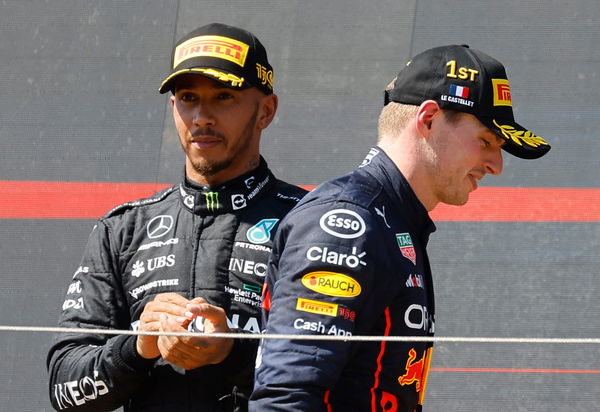
via Reuters
Formula One F1 – French Grand Prix – Circuit Paul Ricard, Le Castellet, France – July 24, 2022 Red Bull’s Max Verstappen celebrates on the podium after winning the race with second place Mercedes’ Lewis Hamilton REUTERS/Eric Gaillard

via Reuters
Formula One F1 – French Grand Prix – Circuit Paul Ricard, Le Castellet, France – July 24, 2022 Red Bull’s Max Verstappen celebrates on the podium after winning the race with second place Mercedes’ Lewis Hamilton REUTERS/Eric Gaillard
Lewis Hamilton hasn’t won a race in over a year and a half now. To top it off, arch-rival Max Verstappen is running away with the championship as the Dutchman threatens to establish his dominance for a long period. After Lewis Hamilton’s suggestion to stop Max Verstappen’s dominance fails, FIA’s attempt to do the same is humiliated as evidence comes to light. What is this evidence?
Red Bull reportedly started the development of the 2024 competitor long before Mercedes did. In an attempt to stop Max Verstappen and Red Bull from dominating in the coming years, Lewis Hamilton suggested that FIA specify a date when the teams can start development of next year’s car. Not taking Hamilton’s suggestion into consideration, FIA is reported to implement a new rule to stop Max Verstappen and Red Bull from dominating.

via Reuters
Formula One F1 – Monaco Grand Prix – Circuit de Monaco, Monte Carlo, Monaco – May 28, 2023 Red Bull’s Max Verstappen leads into the first corner at the start of the race ahead of Aston Martin’s Fernando Alonso REUTERS/Piroschka Van De Wouw
It was recently suggested that the FIA is planning to ban the DRS from the qualifying session. Red Bull has the most efficient DRS system and taking it away was believed to bring the rest of the grid closer to the Red Bulls. However, a recent analysis suggests that it wouldn’t be making a major difference.
ADVERTISEMENT
Article continues below this ad
According to F1Maximaal.nl, The Race did an analysis of Red Bull’s DRS efficiency in race and qualifying and was then compared to the closest non-Red Bull car. In Jeddah, Checo was over 4 tenths quicker than Alonso with the DRS open whereas that advantage was cut short to just over a tenth without the DRS. This suggested that Checo has a 3-tenth advantage with DRS available. However, the gap to Alonso in qualifying was 0.465 seconds which means Perez would’ve finished ahead of Alonso anyways.
The case remained the same when the analysis for Barcelona was done. Max Verstappen had a 0.229-second advantage over Lewis Hamilton with the DRS open. However, the gap to Hamilton in qualifying was over 7 tenths which meant that Verstappen still would have finished ahead even without the DRS.
Read More: F1 Champ Snubs Max Verstappen as Red Bull’s Most Valuable Asset, Names Another Key Figure
The only place where it would’ve made a difference was in Austria where Charles Leclerc would’ve finished ahead of Verstappen given the fact that DRS wasn’t available in qualifying. However, all of this is still not the full story.
ADVERTISEMENT
Article continues below this ad
DRS isn’t the only factor making Red Bull faster, it’s the overall Aerodynamic efficiency
If we look at the percentage of advantage gained over the closest non-Red Bull car with the help of DRS, only a 30% gain of the total advantage was made with the help of DRS in Spain. Whereas if we look at Jeddah, the percentage increases to over 60%. While there definitely is an advantage, it wouldn’t change the results of the qualifying, just reduce the gap to the competition.

via Reuters
Formula One F1 – Spanish Grand Prix – Circuit de Barcelona-Catalunya, Barcelona, Spain – June 4, 2023 Red Bull’s Max Verstappen in action as he leads into the first corner at start of the race ahead of Ferrari’s Carlos Sainz Jr. REUTERS/Albert Gea TPX IMAGES OF THE DAY
Also, if the DRS wouldn’t have been available, the setup for the cars would’ve been different hence a definite conclusion cannot be made. The gap is also dependent on the kind of track. Austria where Leclerc would’ve beaten Verstappen is a track dominated by straight. It’s not the DRS but the overall aerodynamic efficiency of Red Bull because of which it is so dominant. DRS is just a part of that advantage. So, even if the FIA decides to implement the DRS ban in qualifying, Red Bull will still come out on top.
ADVERTISEMENT
Article continues below this ad
What do you think about this analysis? Do you agree that Red Bull will still triumph even if DRS was disabled for the qualifying?
WATCH THIS STORY | Christian Horner Sparks Rivalry: Toto Wolff’s F2 Remark Refuted
ADVERTISEMENT
ADVERTISEMENT
ADVERTISEMENT
ADVERTISEMENT

